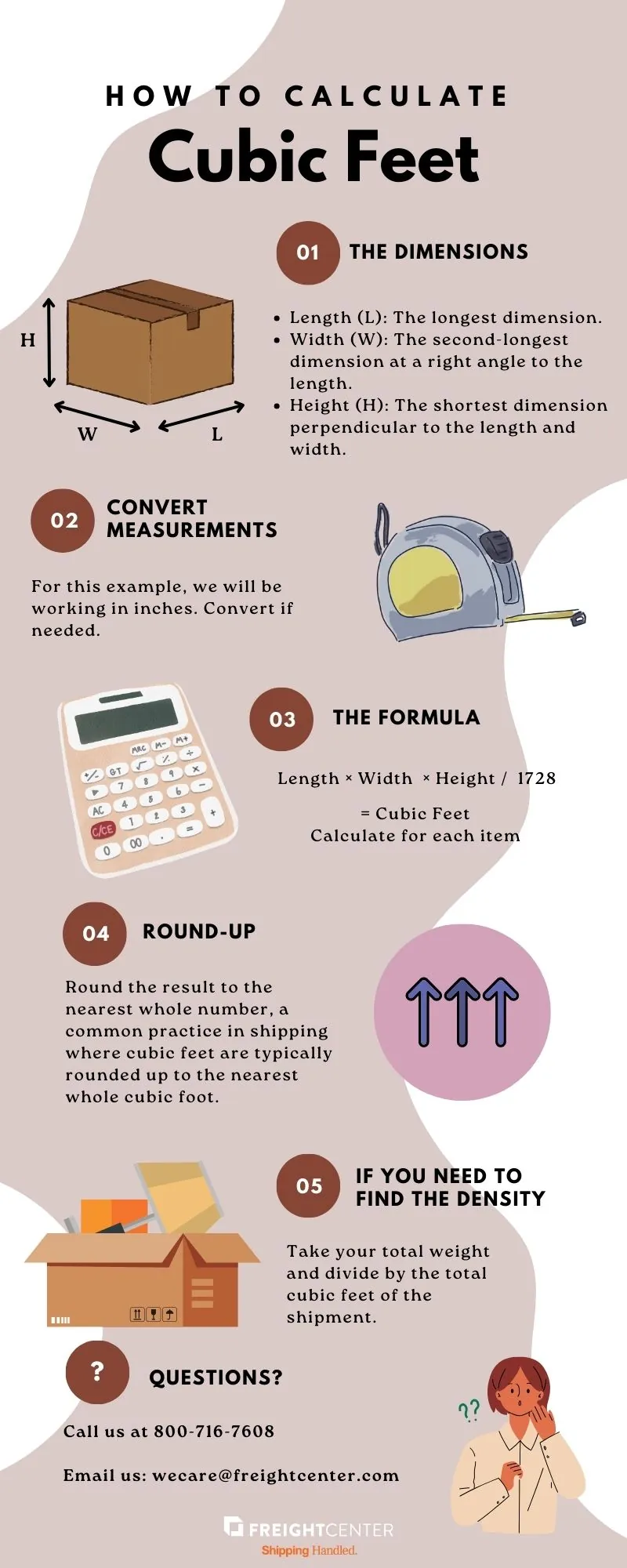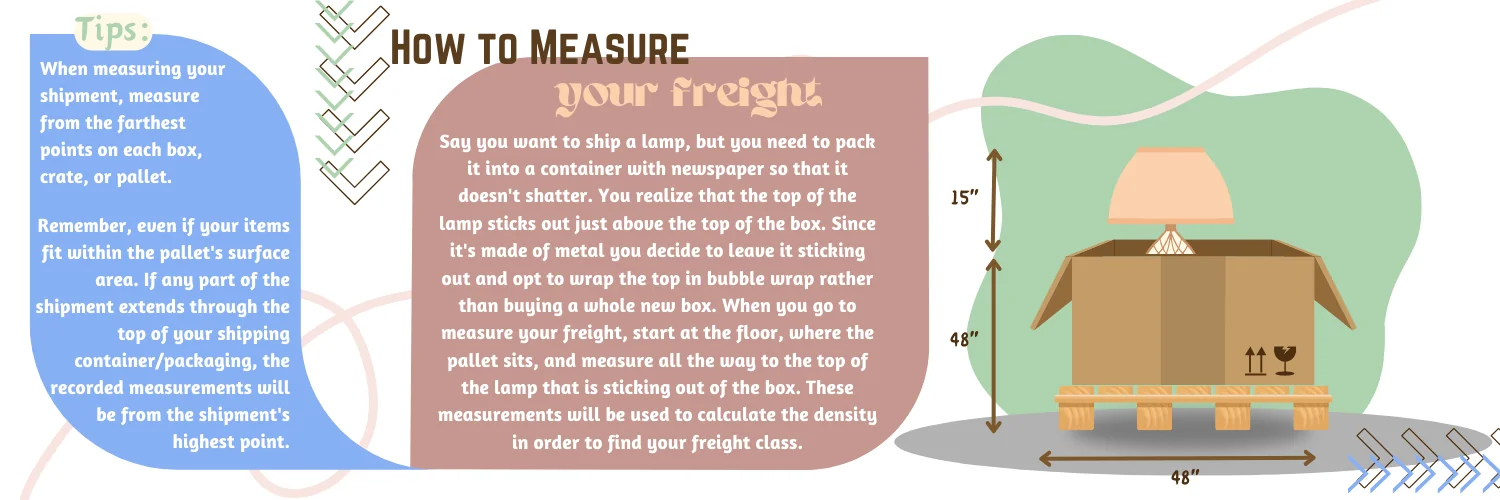
Cubic Feet
In the freight industry, calculating cubic feet is essential for optimizing cargo space, determining shipping costs based on dimensional weight, and strategically packing shipments to minimize wasted space, ultimately contributing to more cost-effective and efficient logistics operations.
Role of Cubic Feet in Freight Logistics
In the intricate dance of freight shipping logistics, cubic feet emerges as a vital player, determining the three-dimensional space a package occupies. Beyond a mere unit of measurement, the measurement becomes a navigational tool guiding strategic decisions for carriers and shippers alike. Cubic feet calculators are an easy way to find your cubic feet without much effort. It shapes how cargo space is allocated within transport vehicles and influences the meticulous calculation of shipping costs.
As carriers endeavor to strike a balance between weight and volume for equitable pricing, understanding the measurement becomes a strategic advantage. Shippers armed with this knowledge can pack with precision, strategically minimizing wasted space and, in turn, reducing overall shipping expenses. Cubic feet transcends its numerical value; it is the compass steering both carriers and shippers toward streamlined operations, ensuring optimal utilization of available space in the complex world of shipping logistics. It is in this fusion of measurement and strategy that cubic feet plays a crucial role, navigating the course toward efficiency and cost savings.
Thousands of businesses trust FreightCenter to move their freight faster, smarter, and cheaper! From unbeatable rates to top-notch service, our customers are raving about their shipping success.
See why they keep coming back!
Award-Winning Service, Trusted by Shippers Everywhere!
- 2021, 2017 & 2016 Food Logistics’ Top Green Providers
- 2021 & 2018 Supply & Demand Chain Executives’ Pros to Know: Matthew Brosious
- 2020 & 2019 Top Food Logistics’ 3PL & Cold Storage Provider Award
- 2020 & 2019 Business Observer’s Top 500 Companies on the Gulf Coast
- 2020 & 2017 SmartWay® Transport Partner
- 2020 & 2017 Food Logistics’ Champions: Rock Stars of the Supply Chain
- 2020 Best of Palm Harbor Awards for Local Businesses
- 2017 Green Supply Chain Award from Supply & Demand Chain Executive
- 2017 Tampa Bay Business Journal Heroes at Work
- 2016, 2015, & 2012 Food Logistics Top 100 Software and Technology Providers
- 2013 Tampa Bay Business 100 by Tampa Bay Business Journal
- 2013 Top 100 Great Supply Chain Partners by SupplyChainBrain
- 2012 TIA Samaritan Award Honorable Mention
- 2012, 2011 & 2010 TBBJ Fast 50 Recipient
- 2013, 2011, & 2010 Diversity Business Top Businesses

Cubic Feet: The Formula
Measurements: Begin by measuring the package dimensions:
- Length (L): Measure the longest dimension of the package.
- Width (W): Measure the second-longest dimension at a right angle to the Length.
- Height (H): Measure the shortest dimension perpendicular to the length and width.
Ensure that all measurements are in feet for consistency.
Convert Measurements to inches: In this example, we are using inches. Convert if needed.
Apply the Formula: Utilize the cubic feet formula: Cubic Feet = Length ×Width × Height / 1728
Round-Up: Round the result to the nearest whole number, a common practice in shipping where the measurement is typically rounded up to the nearest whole cubic foot.
Example: For a single package with dimensions 45 inches (L) x 20 inches (W) x 30 inches (H):
- Apply the formula: 45 x 20 x 30 = 27000 / 1728 = 16 cuft
- Take your total cubic feet and divide by the total weight and you get your shipment density.
- If your shipment weighs 500Ibs then 16 / 500 = 32.2 ppcft
Consider Multiple Packages: When dealing with multiple packages, calculate the measurement for each package separately and then add them together to determine the total cubic volume. This comprehensive approach ensures accurate measurements and facilitates effective shipping logistics.
Cubic Feet in Logistics
In the dynamic world of shipping, where efficiency and precision are paramount, the concept of cubic feet plays a pivotal role. The measurement is not merely a mathematical abstraction; it’s a practical measurement that significantly influences shipping processes, costs, and the overall logistics landscape.
Navigating Shipping Costs
Shipping costs are a multifaceted equation, with weight and volume both playing pivotal roles. The measurement comes into play, especially for items that may be lightweight but occupy significant space. Carriers frequently employ the concept of dimensional weight, where charges are levied based on the space a package occupies, ensuring fair pricing for cargo space utilization.
Efficient Space Utilization
In the logistics industry, the efficient use of cargo space is a game-changer. Calculating cubic feet allows carriers to maximize the number of packages transported in a single shipment, enhancing overall efficiency, and simultaneously curbing costs. It’s a strategic move that ensures every inch of cargo space is utilized optimally.
Strategic Packing
For shippers, knowing the cubic feet of their packages is akin to wielding a strategic tool. It empowers them to choose appropriate packaging materials and arrange items within a box with precision, minimizing wasted space and potentially reducing shipping expenses.
Freight Class and Cubic Feet:
In freight shipping, the interplay between this freight class is significant. Freight class, which considers both density and volume, helps carriers determine the appropriate shipping rate. The measurement becomes a critical factor in this equation, shedding light on the spatial characteristics of the shipment.
The following calculators and tools can help make your shipping process easier by doing the work for you; all you need are your measurements and weight.
Freight Class Calculator
Every shipped item falls into one of 18 freight classes, represented by numeric numbers ranging from class 50 to 500. Using a Freight Class Calculator to determine your class is essential to ensuring your rate is good.
Density Calculator
Freight density refers to the measurement of how much space a shipment occupies in relation to its weight. It is determined by calculating the weight of a shipment in pounds per cubic foot (PCF). The higher the weight per cubic foot, the denser the shipment is, and the lower the weight per cubic foot, the less dense the shipment is.
NMFC Lookup Tool
Freight class is an industry-wide numeric classification system categorizing commodities transported through LTL shipping. The National Motor Freight Traffic Association defines the freight classes and makes them available through the National Motor Freight Classification (NMFC).
NOI Calculator
When shipping freight, you may come across the acronym N.O.I. This stand for Not Otherwise Indicated. Not every item is classified by the National Motor Freight Classification index. In these cases, shippers may need to call for real-time N.O.I. freight rating.

Frequently Asked Questions
Q. How do you calculate shipping volume in cubic feet?
A. To calculate shipping volume in cubic feet, first measure your package’s length, width, and height in inches. Multiply these dimensions (L x W x H) to find the volume in cubic inches. Then, divide this number by 1728 to convert it to cubic feet, ensuring your shipping calculations are accurate.
Q. What is cubic capacity in shipping?
A. Cubic capacity in shipping refers to the maximum volume of space that cargo can occupy in a shipping container or trailer. It’s critical for carriers, especially in Less-than-truckload (LTL) shipping. It ensures that freight charges are proportional to the space used if cargo density is below a set threshold, typically when it exceeds 750 cubic feet but weighs under six pounds per cubic foot.
Q. What is CBM and CFT?
A. CBM stands for Cubic Meter, which measures volume in the metric system, while CFT refers to Cubic Feet used in the imperial system. Both units indicate a three-dimensional object’s space, with CBM commonly employed in international shipping and CFT often used in the United States.


